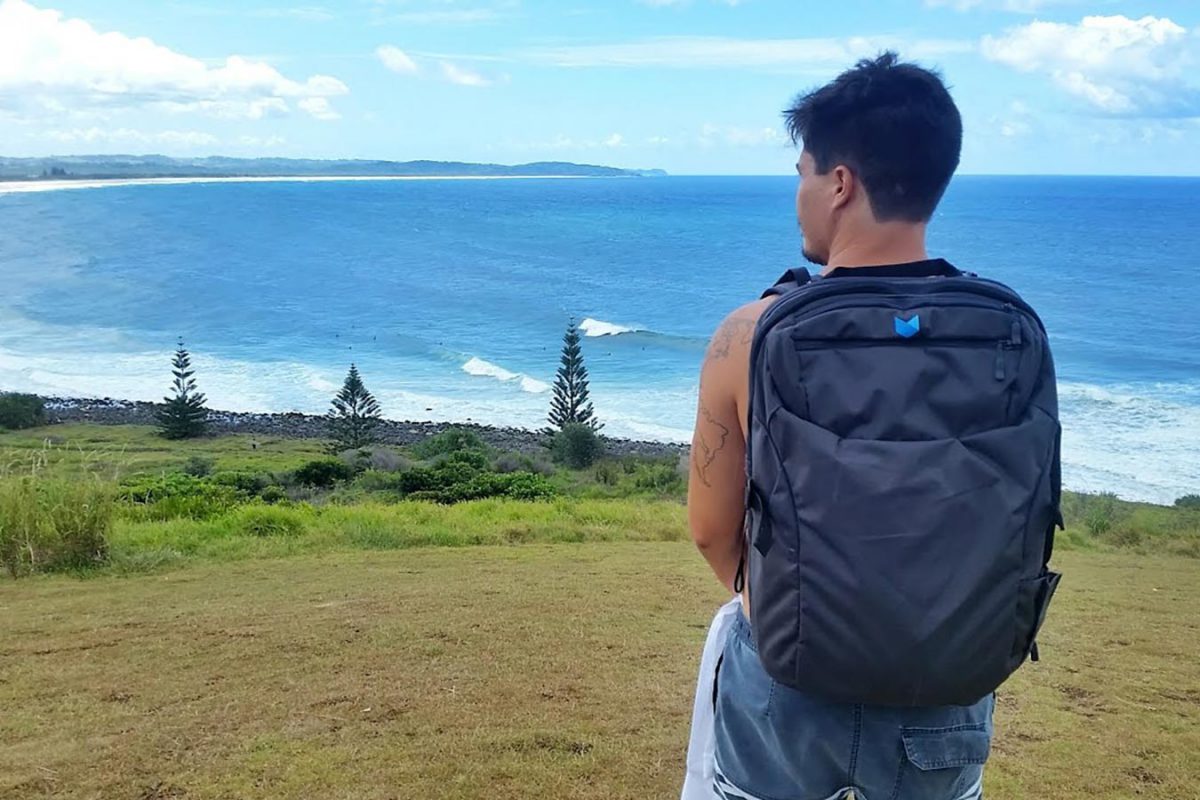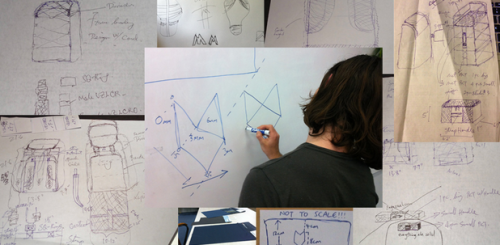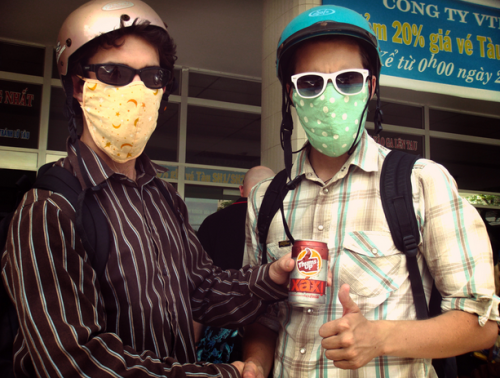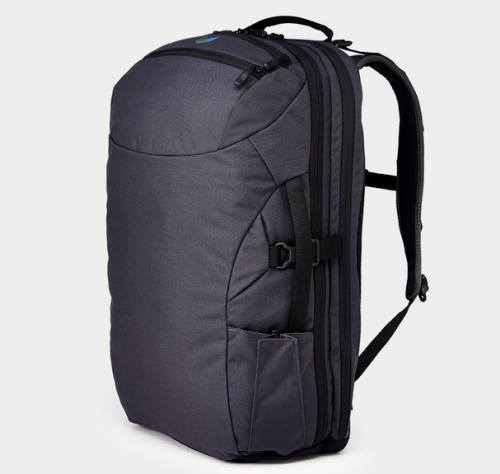
Jimmy Hayes, co-founder of Minaal, has the travel bug bad. It started innocently enough when, while on university exchange in Vancouver, he and his friend Doug Barber bought a Plymouth Grand Voyager van and drove 18,000 miles around North America. Little did they know it then, but their shared wanderlust was a brilliant travel solution in the making.
After logging miles on the road and in the air, the two longed to create a bag for people that would help them travel faster, happier and more productively.
The only hitch? They had no design, sourcing or manufacturing background whatsoever.
The Carry-On Quandary
The idea for creating the Minaal bag came from trying to solve a traveler’s problem – faulty luggage.
The two spotted a gap in the market for people that needed something lightweight but roomy, sturdy yet spacious, and wanted to fill that void. A backpack was the most natural first step, since it’s the easiest style for people on the go. They needed something that didn’t have to be on wheels and was super lightweight.
And then there was the vanity aspect. Backpacks look natural on student travelers, but are harder if you’re someone that goes from the backcountry to the boardroom in one trip. They weren’t sure if they were just making a bag for themselves, but they knew they stumbled upon a really underserved niche: the constant traveler.
As any good brand does, Minaal started things off with a mission statement. They coined a term they were fighting against – travel drag. “Travel drag is anything that weighs you down mentally or physically from reaching your destination,” says Jimmy.
They started to attack travel drag by taking all the good features of classic backpacks and carry-ons to create a better product. But first they had to figure out how to do it.
Backpacks look natural on student travelers, but are harder if you’re someone that goes from the backcountry to the boardroom in one trip.
Designing the Ultimate Bag
When they were pursuing the creation of their bag, Jimmy and Doug weren’t consumed by careers or bogged down by a desk job. Travel was their primary career.
“I was never working full-time, long-term,” says Jimmy. “I did weird jobs like driving an ice cream truck for 24 hours and then working on a TV ad for the next 24 hours. After about 4 months I’d have enough saved for my next trip.”
Doug had a steadier gig and would work a full-time job for two years and then travel for two years. So how did two guys find the confidence to build an entirely new product design and manufacturing plan without any credentials?
“We felt the problem, looked at the problem and decided it was one that could be served from a small company,” says Jimmy. “Having a business partner that had complete quiet conviction was huge – without that I wouldn’t be here.”
His undying travel obsession also didn’t hurt.
“We’re both full of ‘Why not?’” says Jimmy. He knew their only regret would be if they never tried to get their idea off the ground.
The Prototype
Though neither had a background in design, their strongest skill was knowing their weaknesses and surrounding themselves with the right people who could answer their questions.
They started to sketch out ideas, but knew they’d need to hire a professional that could help them create an actual pattern.
Their original plan was to find a manufacturer to translate their design.
“We called one manufacturer in New Zealand and they told us they were too busy to help, but referred us to a guy that might be able to work with us,” says Jimmy.
Deciding not to use a manufacturer for both the design and implementation turned out to be a blessing. “The use case was too important to leave just to a manufacturer,” says Jimmy.
A two-month process between Jimmy and Doug resulted in a 5-page design brief. Then came a first round of design between them and their designer, more feedback and gradual iteration until a prototype was born, all with an initial investment of just under $10,000 to hire a professional designer.
“We worked hard to put together a strong design brief that sent a message that we were serious about this,” says Jimmy. Not only did it help make them look professional, but it aided the designer in line with their shared vision.
“He was the one who ultimately came up with the final execution and the spec sheets for us to take over to the factory,” says Jimmy. “We physically could not make that so it was cool to have someone on board that could do it with us.”
Choosing The Right Factory
Jimmy won’t sugarcoat it: “This is not the easiest part of the process!”
They spent time showing up at the doors of many manufacturers as they traveled the world and asked to be shown around. “It was a real learning experience – it was our post-grad education,” says Jimmy.
Bewildered more than taken aback, manufacturers would take them on a tour when they showed up. Throughout the process they got a few random names and emails and started visiting various countries to pick the right candidate, ultimately landing on a manufacturer in Vietnam.
“We had this assumption that you’re choosing between high-cost, high-quality Western manufacturing versus low-cost, low-quality Eastern manufacturing. Asia was just as high in quality as anywhere else. In the end, the manufacturer we chose had amazing quality, great labor standards, was trustworthy, able to scale indefinitely – they just ticked every box.”
Do Your Due Diligence
It takes more than a single visit to a manufacturer to know if they’re the right fit. There were a few important factors that helped them cement their decision.
First, they checked out the gear that the factories were already making, including the brands that had hired them. “If it passes the quality checks of some of these higher-end, well-respected brands, it would probably check ours as well,” says Jimmy.
When it came to labor equality, they made sure the manufacturer was verified by an organization that does just that. As far as measuring trust – that was more of a toss-up.
“Trustworthiness was a risk you could take – for us it came down to a gut feeling,” says Jimmy.
They also wanted to look at the capacity of the manufacturer to make sure they could accommodate any volume of orders that would come through. In the end, the two remained hands-on throughout the process long after the decision to hire a manufacturer was made.
“Many large companies send people in to review hundreds of models at once, give them a look and then they get chucked back to the manufacturer,” says Jimmy. “But we sat in all day meetings and discussed things like how the zipper should work. Once we placed the production order, we were there right through the process.”
Sourcing Channels: All In The Details
Buckles. Straps. Zippers. Buttons.
The manufacturer did most of the work sourcing the bag components by leveraging existing relationships and huge economies of scale.
“This would not have been viable for us to do ourselves because this bag has 18 classes of items, some of which are in multiples. If each size of a zipper is a different class, you’re dealing with a lot of different suppliers.”
Their prototype was a very good first representation of what they wanted, but in the end, there were hundreds of small tweaks and changes that Doug and Jimmy made.
In terms of the iteration process, they were learning as they went. Their designer was always on call and available to jump on Skype if he was needed.
Whenever the two went up against resistance from the manufacturers, they softly pushed back. “At times we got frustrated, but it was never us yelling at them. It was important that we found out the reasons why we couldn’t have things a certain way.”
In the end, the processes that they assumed would be simple ended up being some of the hardest decisions to make, like deciding on the pullers on the zippers. “Our manufacturer was used to working with such a high level of clients that usually came knowing what they wanted in the details or just didn’t care either way,” says Jimmy.
Promoting The Product
Once the product was in its final stages, they looked to Kickstarter to get their brand up and running. Their goal was to raise $30,000. They ended up raising ten times that much. There are a few skills needed in order to pull off an insanely successful kickstarter campaign.
“There are a million little things that go into this success and you can’t underestimate creating the right product at the right time,” says Jimmy.
A lot of it, he says, fell to luck. But besides having lady luck on their side, they focused on two key things as they went from product design and manufacturing to a final product.
Do The Grunt Work Before Going Live
Jimmy and Doug wanted people that weren’t friends and family to provide honest feedback on their Kickstarter draft. They had multiple rewrites, image changes and more based on what people thought of it. They also spent a solid month or so contacting media ahead of time to help promote the campaign, rather than wait until they had already launched.
“For us an email blast to 5,000 people didn’t feel right,” says Jimmy. “Instead, we wrote cold emails for hundreds of people that resulted in massive strain to my wrists!”
They cared about each person behind the email address and wanted to pitch them correctly, be friendly and not waste their time as a spammer. The two had also met a lot of podcasters and bloggers from their travels who had been invested in their process and by the time they went live, they were excited to share the news.
Though they spent time reaching out to big circulating editorial magazines and huge websites, they didn’t have much success from the larger circulations. Luckily they didn’t need it. On the road they met a bunch of people with platforms who were excited about what they were doing. Those friends had a much bigger effect than any kind of work from the bigger editorial beats.
For us an email blast to 5,000 people didn’t feel right,” says Jimmy. “Instead, we wrote cold emails for hundreds of people that resulted in massive strain to my wrists!”
Jimmy and others weighed in on how to launch and run a successful Kickstarter campaign in this Kickstarter thread in the private forum. If you’re not a member, you can learn more about the community and apply for membership here.
Focus On a Killer Video
With some background in TV work, Jimmy set to write the video’s script in an afternoon. They asked a photographer friend to handle the camera with Jimmy as the second shooter. It was shot and edited within a few days.
The direct cost was less than $1,000. Indirect costs were more, with the purchase of a new camera, but still came in under $1,000 when all was said and done. “Time spent and years taken off my life were significantly higher,” laughs Jimmy.
Here was the final product:
[embedded content]
[embedded content]
“We had mentally run through every possible scenario before our Kickstarter went live and as a planning mechanism that is super important,” says Jimmy. “What will happen if we don’t make it? What will happen if we hit a million dollars on day 3?”
They ran over every possibility in their head so they wouldn’t freak out, but they were deliriously happy and sleep deprived when the numbers started rolling in and they ended up raising nearly $350,000.
“There were lots of high fives, but more relief than anything else.”
The Future of Minaal
The goal has always been to own the traveler’s niche, not for their brand to grow super huge or end up in retail.
“We’re dealing with an investment bag, people want to touch it and feel it – we can go by word of mouth at first, but as we scale, we’ll have to interact with the real world,” says Jimmy.
Bridging the gap between the travel world and the eCommerce world means going to events and letting people try on the bag in person.
One thing not in their immediate plan is to sell on Amazon. At least not right away. “We are going to look into it, but the control over the channel is important to us.”
One thing the two do know for sure – this is the only bag they’ll travel with on their next adventure.
If you want to learn more about bringing your brilliant idea from a design to conception from cool eCommerce experts like Jimmy, you’ll find other successful eCommerce independent store owners, designers, manufacturing experts and more in our private forum. You can learn more and apply for membership here.
Photos courtesy of Jimmy Hayes. This post was taken from our podcast on the Minaal Bag with Jimmy Hayes. You can learn more about this bag at Minaal.com. Original podcast produced by Andrew Youderian with post written by Laura Serino.






